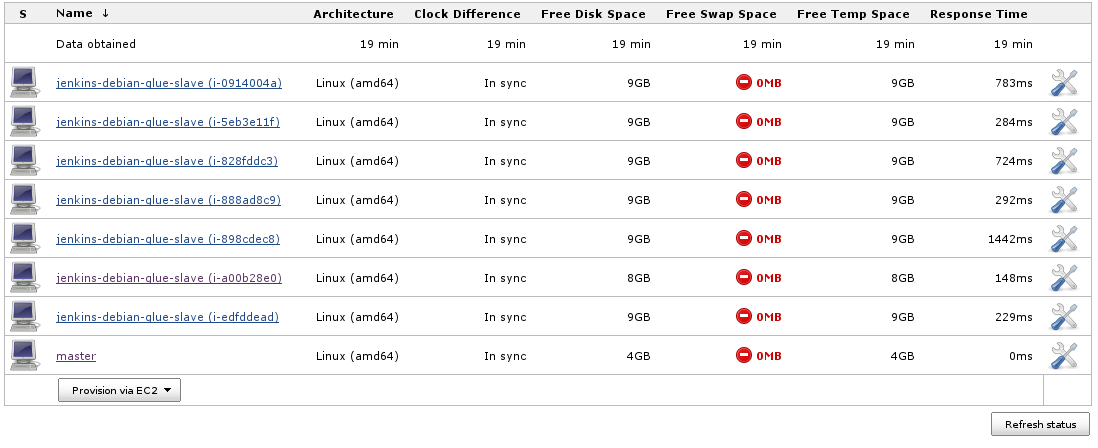Building Debian+Ubuntu packages on EC2
In a project I recently worked on we wanted to provide a jenkins-debian-glue based setup on Amazon’s EC2 for building Debian and Ubuntu packages. The idea is to keep a not-so-strong powered Jenkins master up and running 24×7, while stronger machines serving as Jenkins slaves should be launched only as needed. The project setup in question is fully open sourced (more on that in a piuparts (.deb package installation, upgrading, and removal testing tool) on the resulting binary packages. The Debian packages (source+binaries) are then provided back to Jenkins master and put into a reprepro powered Debian repository for public usage.
Preparation
The starting point was one of the official Debian AMIs (x86_64, paravirtual on EBS). We automatically deployed jenkins-debian-glue on the system which is used as Jenkins master (we chose a m1.small instance for our needs).
We started another instance, slightly adjusted it to already include jenkins-debian-glue related stuff out-of-the-box (more details in section “Reduce build time” below) and created an AMI out of it. This new AMI ID can be configured for usage inside Jenkins by using the Amazon EC2 Plugin (see screenshot below).
IAM policy
Before configuring EC2 in Jenkins though start by adding a new user (or group) in AWS’s IAM (Identity and Access Management) with a custom policy. This ensures that your EC2 user in Jenkins doesn’t have more permissions than really needed. The following policy should give you a starting point (we restrict the account to allow actions only in the EC2 region eu-west-1, YMMV):
{
"Version": "2012-10-17",
"Statement": [
{
"Action": [
"ec2:CreateTags",
"ec2:DescribeInstances",
"ec2:DescribeImages",
"ec2:DescribeKeyPairs",
"ec2:GetConsoleOutput",
"ec2:RunInstances",
"ec2:StartInstances",
"ec2:StopInstances",
"ec2:TerminateInstances"
],
"Effect": "Allow",
"Resource": "*",
"Condition": {
"StringEquals": {
"ec2:Region": "eu-west-1"
}
}
}
]
}
Jenkins configuration
Configure EC2 access with “Access Key ID”, “Secret Access Key”, “Region” and “EC2 Key Pair’s Private Key” (for SSH login) inside Jenkins in the Cloud section on $YOUR_JENKINS_SERVER/configure. Finally add an AMI in the AMIs Amazon EC2 configuration section (adjust security-group as needed, SSH access is enough):

As you can see the configuration also includes a launch script. This script ensures that slaves are set up as needed (provide all the packages and scripts that are required for building) and always get the latest configuration and scripts before starting to serve as Jenkins slave.
Now your setup should be ready for launching Jenkins slaves as needed:

NOTE: you can use the “Instance Cap” configuration inside the advanced Amazon EC2 Jenkins configuration section to place an upward limit to the number of EC2 instances that Jenkins may launch. This can be useful for avoiding surprises in your AWS invoices. :) Notice though that the cap numbers are calculated for all your running EC2 instances, so be aware if you have further machines running under your account, you might want to e.g. further restrict your IAM policy then.
Reduce build time
Using a plain Debian AMI and automatically installing jenkins-debian-glue and further jenkins-debian-glue-buildenv* packages on each slave startup would work but it takes time. That’s why we created our own AMI which is nothing else than an official Debian AMI with the bootstrap.sh script (which is referred to in the screenshot above) already executed. All the necessary packages are pre-installed and also all the cowbuilder environments are already present then. From time to time we start the instance again to apply (security) updates and execute the bootstrap script with its ‐‐update option to also have all the cowbuilder systems up2date. Creating a new AMI is a no-brainer and we can then use the up2date system for our Jenkins slaves, if something should break for whatever reason we can still fall back to an older known-to-be-good AMI.
Final words
How to set up your Jenkins jobs for optimal master/slave usage, multi-distribution support (Debian/Ubuntu) and further details about this setup are part of another blog post.
Thanks to Andreas Granig, Victor Seva and Bernhard Miklautz for reading drafts of this.